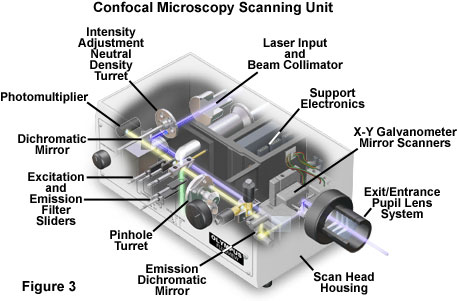Fred brakenhoff developed a scanning confocal microscope in 1979 21 while almost simultaneously colin sheppard contributed to the technique with a theory of image formation 22.
Disadvantages of laser scanning microscopes.
Confocal microscopy most frequently confocal laser scanning microscopy clsm or laser confocal scanning microscopy lcsm is an optical imaging technique for increasing optical resolution and contrast of a micrograph by means of using a spatial pinhole to block out of focus light in image formation.
Can produce 3d.
Confocal is a powerful tool but it does have some limitations.
When investigating multilayer structures the true surface of a substrate can be observed through a surface coating.
Laser scanning confocal microscope.
It provides the ability to collect sharply defined optical sections from which three dimensional renderings can be created.
Where electrons are used to form images.
Capturing multiple two dimensional images at different depths in a sample enables the.
Electrons are reflected off the specimen to produce a 3d image.
Speed a typical confocal uses raster scanning which means it scans the specimen point by point.
Here are 3 quick ones.
The high resolution three dimensional images produced by sems provide topographical morphological and compositional information makes them invaluable in a.
Scanning electron microscope advantages and disadvantages in imaging components and applications.
Light microscope transmission electron microscope scanning electron microscope and laser scanning confocal microscope.
Advantages and disadvantages of confocal microscopy.
Laser scanning confocal microscopy is a significant advance in the field of optical microscopy primarily because it permits sample visualization deep within living and fixed cells tissues and other samples.
A the use of microscopy to observe and investigate different types of cell and cell structure in a range of eukaryotic organisms to include an appreciation of the images produced by a range of microscopes.
Advantages of confocal laser scanning microscopy industrial applications of confocal microscopy thin film profiling.
The primary advantage of laser scanning confocal microscopy is the ability to serially produce thin 0 5 to 1 5 micrometer optical sections through fluorescent specimens that have a thickness ranging up to 50 micrometers or more.
A scanning electron microscope sem is a powerful magnification tool that utilizes focused beams of electrons to obtain information.
Comparing to a wide field detection taking a snapshot of.
Expired practical laser scanning confocal microscope designs were translated into working instruments by several investigators.










